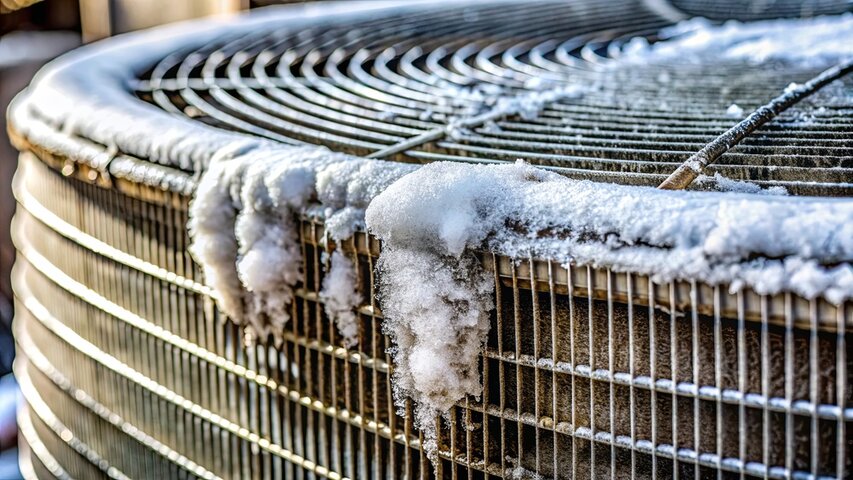HVAC Freezing Up In Summer Las Cruces. Las Cruces, New Mexico is known for its scorching summers and relentless sunshine. In a climate where daily temperatures often exceed triple digits, having a properly functioning HVAC (Heating, Ventilation, and Air Conditioning) system is essential—not just for comfort but also for home safety and well-being. When your AC unit, designed to combat the intense heat, starts to freeze up, it’s more than just an inconvenience; it’s a serious issue that requires immediate attention. Every Las Cruces homeowner needs to know why this happens, what steps to take when it does, and the difference between indoor and outdoor unit freezing.
Why Do HVAC Units Freeze Up During the Summer?
It may seem strange for an air conditioner to freeze up when it’s hot outside, but ice buildup is a common sign of an issue that prevents the unit from functioning. Air conditioners operate by absorbing heat from indoor air using a cold refrigerant that circulates through the evaporator coils (indoor unit) and then releasing that heat outside through the condenser coils (outdoor unit). If the refrigerant isn’t absorbing enough heat or if airflow over the coils is restricted, the temperature of the evaporator coil can drop below freezing, causing condensation on its surface to freeze into ice.
Here are the primary culprits behind AC unit freezing:
Low Refrigerant Levels (Refrigerant Leak): This is perhaps the most common reason. If your system is low on refrigerant due to a leak, the pressure within the system drops. Lower pressure means the refrigerant gets excessively cold as it expands in the evaporator coil, causing the coil temperature to plummet below freezing and ice to form.
Restricted Airflow Over the Evaporator Coil: The evaporator coil needs a constant flow of warm indoor air passing over it to absorb heat effectively. If airflow is blocked, the coil can’t absorb enough heat, leading to its temperature dropping too low. Common culprits for restricted airflow include:
Dirty Air Filters: This is the easiest and most frequent cause. A clogged filter severely restricts the amount of air passing over the coil, choking the system.
Blocked Return Air Vents: Furniture, drapes, or other obstructions covering the return air vents prevent warm air from entering the HVAC system.
Closed Supply Vents: While less common to cause freezing directly, closing too many supply registers in different rooms can disrupt the overall airflow balance, leading to pressure issues that contribute to freezing.
Dirty Evaporator Coil: Over time, dust, dirt, and debris can accumulate directly on the evaporator coil’s fins, acting as an insulating layer that prevents proper heat transfer.
Malfunctioning Blower Motor/Fan: The blower motor in your indoor unit is responsible for moving air across the evaporator coil and pushing conditioned air through your ducts. If the blower fan isn’t operating at full capacity (e.g., a failing motor, a bent fan blade, or incorrect fan speed settings), insufficient air will pass over the coil, causing it to freeze.
Clogged Condensate Drain Line: As your AC cools your home, it also dehumidifies the air, producing condensation. This water typically drains away through a condensate line. If this line becomes clogged with algae or debris, water can back up, overflow the drain pan, and eventually freeze around the evaporator coil.
Faulty Thermostat: A malfunctioning thermostat might give incorrect signals to your AC unit, causing it to run continuously without proper cycling or to attempt to cool when it shouldn’t, leading to temperature imbalances that can cause freezing.
What to Do When Your AC Unit Freezes Up Inside
Discovering ice on your indoor evaporator coil or lines is a clear sign that something is wrong. Here’s what you should do immediately:
Turn Off Your AC Unit Immediately: This is the most crucial step. Running a frozen unit can cause severe and irreversible damage to expensive components, particularly the compressor, which is the heart of your AC system. Turn the thermostat to the “Off” position.
Allow the Unit to Defrost Naturally: Let the ice melt completely. This can take several hours (4-24 hours), depending on the amount of ice and the ambient temperature. You can place towels around the indoor unit to catch melting water.
Change Your Air Filter: While the unit is defrosting, check your air filter. If it’s dirty, replace it with a clean one. This is the simplest and most common fix for airflow issues.
Check All Vents and Returns: Ensure that all supply and return air vents in your home are open and unobstructed by furniture, drapes, or other items.
Consider Using Your Heat (Carefully): To speed up defrosting, you can switch your thermostat to “Heat” mode (after the AC unit has been off for at least an hour). The warm air from your furnace’s blower will circulate over the frozen coil, melting the ice much faster. Remember to switch it back to “Off” or “Cool” after defrosting.
Inspect the Condensate Drain Line: Look for standing water in the drain pan or signs of a clog. If you’re comfortable, you can attempt to clear a minor clog with a wet/dry vac or a stiff brush.
Call a Professional: If, after defrosting and performing these checks, your unit still freezes up when you restart it, or if you suspect a refrigerant leak, a failing component, or a deeper issue, it’s time to call a qualified HVAC technician in Las Cruces. Do not attempt to add refrigerant yourself, as this requires specialized tools and training.
Air Conditioner Freezing Up Outside Unit
While ice typically forms on the indoor evaporator coil, it’s possible for the outdoor condenser unit’s lines (the larger, insulated line) to also freeze, especially close to where they enter the house. This usually happens for the same underlying reasons as indoor coil freezing: low refrigerant or issues causing the overall system to operate inefficiently and the refrigerant to get too cold.
If your outdoor unit’s lines are frozen, it indicates a serious problem with the refrigerant cycle or airflow. The same immediate action applies: turn off the unit. Continuing to run it will exacerbate the problem and could lead to compressor failure.
Consequences of a Frozen Outdoor Unit (or any frozen AC unit):
Reduced Cooling Capacity: Ice acts as an insulator, preventing the coils from properly absorbing or releasing heat. This drastically reduces the unit’s ability to cool your home, leading to uncomfortable temperatures and wasted energy.
Compressor Damage: The most severe consequence. When ice builds up, the system’s pressures become dangerously imbalanced. The compressor, which is designed to pump refrigerant, will struggle against these incorrect pressures and can overheat, seize, or suffer liquid slugging (when liquid refrigerant returns to the compressor), leading to catastrophic and very expensive failure.
Fan Motor Damage: The blower motor (indoor) or condenser fan motor (outdoor) can also be strained trying to push air through a blocked, icy coil, leading to premature wear or burnout.
Water Damage: As the ice melts, it can cause water overflow from the drain pan, potentially leading to water damage to your ceilings, walls, or flooring.
Higher Energy Bills: A frozen unit works harder to achieve the desired temperature, consuming more energy and driving up your utility bills without providing adequate cooling.
In Las Cruces, staying on top of your HVAC unit’s health is paramount. Regular preventative maintenance by a professional can identify and address potential issues before they lead to inconvenient and costly ice buildups. Don’t let a frozen AC unit leave you sweating through the desert summer; know what to do and when to call the experts.
When faced with a troublesome AC unit in Las Cruces, On the Go Heating and Cooling stands out as a reliable and customer-focused solution. Specializing in both residential and light commercial services, they offer comprehensive repair and installation for air conditioners, furnaces, heat pumps, and ductless mini-split systems. Their commitment goes beyond simple fixes; they prioritize clear communication, educating customers on the issue at hand and offering affordable preventative maintenance plans to avoid future problems. With 24-hour service, financing options, and a dedicated team of certified technicians, On the Go Heating and Cooling aims to build lasting relationships with their Las Cruces clients, ensuring comfortable indoor environments year-round.

